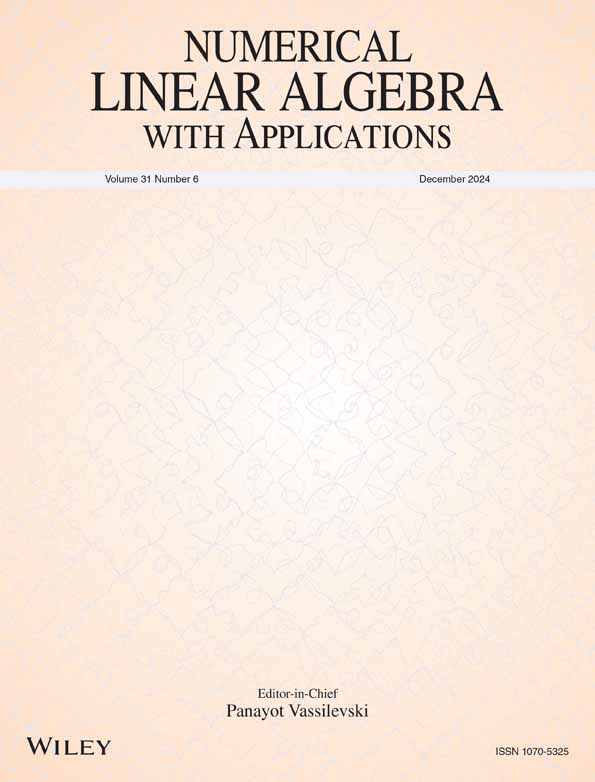Accurate bidiagonal decompositions of Cauchy–Vandermonde matrices of any rank
Jorge Delgado
Departamento de Matemática Aplicada, Universidad de Zaragoza, Edificio Torres Quevedo, Zaragoza, Spain
Search for more papers by this authorCorresponding Author
Plamen Koev
Department of Mathematics, San Jose State University, San Jose, California, USA
Correspondence
Plamen Koev, Department of Mathematics, San Jose State University, San Jose, CA 95192, USA.
Email: [email protected]
Search for more papers by this authorAna Marco
Departamento de Física y Matemáticas, Universidad de Alcalá, Alcalá de Henares, Madrid, Spain
Search for more papers by this authorJosé-Javier Martínez
Departamento de Física y Matemáticas, Universidad de Alcalá, Alcalá de Henares, Madrid, Spain
Search for more papers by this authorJuan Manuel Peña
Departamento de Matemática Aplicada, Universidad de Zaragoza, Edificio de Matemáticas, 50019 Zaragoza, Spain
Search for more papers by this authorPer-Olof Persson
Department of Mathematics, University of California, Berkeley, California, USA
Search for more papers by this authorSteven Spasov
Columbia University, New York, 10027 New York, USA
Search for more papers by this authorJorge Delgado
Departamento de Matemática Aplicada, Universidad de Zaragoza, Edificio Torres Quevedo, Zaragoza, Spain
Search for more papers by this authorCorresponding Author
Plamen Koev
Department of Mathematics, San Jose State University, San Jose, California, USA
Correspondence
Plamen Koev, Department of Mathematics, San Jose State University, San Jose, CA 95192, USA.
Email: [email protected]
Search for more papers by this authorAna Marco
Departamento de Física y Matemáticas, Universidad de Alcalá, Alcalá de Henares, Madrid, Spain
Search for more papers by this authorJosé-Javier Martínez
Departamento de Física y Matemáticas, Universidad de Alcalá, Alcalá de Henares, Madrid, Spain
Search for more papers by this authorJuan Manuel Peña
Departamento de Matemática Aplicada, Universidad de Zaragoza, Edificio de Matemáticas, 50019 Zaragoza, Spain
Search for more papers by this authorPer-Olof Persson
Department of Mathematics, University of California, Berkeley, California, USA
Search for more papers by this authorSteven Spasov
Columbia University, New York, 10027 New York, USA
Search for more papers by this authorAbstract
We present a new decomposition of a Cauchy–Vandermonde matrix as a product of bidiagonal matrices which, unlike its existing bidiagonal decompositions, is now valid for a matrix of any rank. The new decompositions are insusceptible to the phenomenon known as subtractive cancellation in floating point arithmetic and are thus computable to high relative accuracy. In turn, other accurate matrix computations are also possible with these matrices, such as eigenvalue computation amongst others.
CONFLICT OF INTEREST STATEMENT
The authors have no conflicts of interest to disclose.
Open Research
DATA AVAILABILITY STATEMENT
Data sharing is not applicable to this article as no new data were created or analyzed in this study.
REFERENCES
- 1Marco A, Martínez J-J, Peña JM. Accurate bidiagonal decomposition of totally positive Cauchy–Vandermonde matrices and applications. Linear Algebra Appl. 2017; 517: 63–84.
- 2Karlin S. Total Positivity. Vol I. Stanford, CA: Stanford University Press; 1968.
- 3Ando T. Totally positive matrices. Linear Algebra Appl. 1987; 90: 165–219.
- 4Fallat SM, Johnson CR. Totally nonnegative matrices, Princeton Series in Applied Mathematics. Princeton, NJ: Princeton University Press; 2011.
- 5Fallat SM. Bidiagonal factorizations of totally nonnegative matrices. Am Math Mon. 2001; 108(8): 697–712.
10.1080/00029890.2001.11919801 Google Scholar
- 6Gasca M, Peña JM. Total positivity and Neville elimination. Linear Algebra Appl. 1992; 165: 25–44.
- 7Koev P. Accurate eigenvalues and SVDs of totally nonnegative matrices. SIAM J Matrix Anal Appl. 2005; 27(1): 1–23.
- 8Koev P. Accurate computations with totally nonnegative matrices. SIAM J Matrix Anal Appl. 2007; 29: 731–751.
- 9Koev P. Accurate eigenvalues and zero Jordan blocks of (singular) totally nonnegative matrices. Numer Math. 2019; 141: 693–713.
10.1007/s00211-019-01022-0 Google Scholar
- 10Mühlbach G. Interpolation by Cauchy–Vandermonde systems and applications. J Comput Appl Math. 2000; 122(1): 203–222.
10.1016/S0377-0427(00)00364-2 Google Scholar
- 11Ribalta A. State space realizations of rational interpolants with prescribed poles. Syst Control Lett. 2001; 43(5): 379–386.
10.1016/S0167-6911(01)00082-2 Google Scholar
- 12Junghanns P, Oestreich D. Numerische lösung des staudammproblems mit drainage. ZAMM - J Appl Math Mech/Z Angew Math Mech. 1989; 69(2): 83–92.
- 13Weideman JAC, Laurie DP. Quadrature rules based on partial fraction expansions. Numer Algorithms. 2000; 24(1): 159–178.
10.1023/A:1019145327098 Google Scholar
- 14Heiligers B. Totally positive regression: E-optimal designs. Metrika. 2002; 54(3): 191–213.
10.1007/s184-002-8364-7 Google Scholar
- 15Imhof L, Studden WJ. E-optimal designs for rational models. Ann Stat. 2001; 29(3): 763–783.
10.1214/aos/1009210689 Google Scholar
- 16Delgado J, Koev P, Marco A, Martínez J-J, Peña JM, Persson P-O, et al. Bidiagonal decompositions of Vandermonde-type matrices of arbitrary rank. J Comput Appl Math. 2023; 426:115064.
10.1016/j.cam.2023.115064 Google Scholar
- 17Anderson E, Bai Z, Bischof C, Blackford S, Demmel J, Dongarra J, et al. LAPACK Users' Guide. 3rd ed., Software Environ. Tools 9 Philadelphia: SIAM; 1999.
10.1137/1.9780898719604 Google Scholar
- 18Demmel JW. Applied Numerical Linear Algebra. Philadelphia: SIAM; 1997.
10.1137/1.9781611971446 Google Scholar
- 19Ablowitz MJ, Fokas AS. Complex variables: Introduction and applications. 2nd ed. Cambridge: Cambridge University Press; 2003.
10.1017/CBO9780511791246 Google Scholar
- 20Koev P, https://www.sjsu.edu/math/about-us/faculty/plamen-koev.php.
- 21Higham NJ. Accuracy and Stability of Numerical Algorithms. 2nd ed. Philadelphia: SIAM; 2002.
10.1137/1.9780898718027 Google Scholar
- 22 ANSI/IEEE. New York, IEEE Standard for Binary Floating Point Arithmetic, Std 754-1985 Edition. 1985.
- 23Demmel J. Accurate singular value decompositions of structured matrices. SIAM J Matrix Anal Appl. 1999; 21(2): 562–580.
- 24 The MathWorks, Inc. Natick. MA: MATLAB Reference Guide; 1992.




